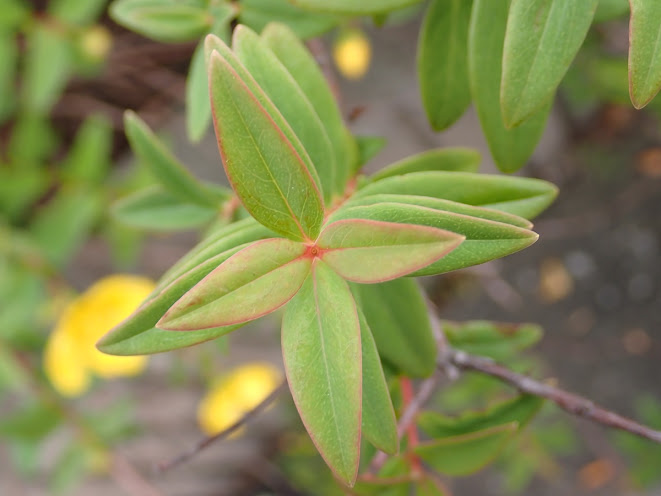A yellow Hypericum flower named after the famous Garden in UK
When I went shopping the other day, I saw an abundance of yellow flowers in roadside bushes near crossroads.

At first, I thought it was a flower of Hypericum patulum. It is native to China and is also known as “金糸梅 (kin shi bai)” in Japan. Incidentally, the Japanese name is derived from the Chinese name “金丝梅”, which likens the five petals to blossoms of a plum called Ume and the long, protruding stamens to golden threads. In fact, “金糸” means golden threads and “梅” means a plum called Ume.
I was curious so I looked it up online. As a result, it is not a flower of Hypericum patulum, “金糸梅”and it was found to be a horticultural variety that grows large and blooms bigger flowers than Hypericum patulum. In Japan it is also known as “大輪金糸梅 (tai rin kin shi bai)”. The meaning of kanji “大輪”is a big blossom.
However, it is commonly called Hypericum ‘Hidcote’. What is ‘Hidcote’, then?
I found Hidcote was the name of a famous garden located in the United Kingdom, so I visited the official website of “Hidcote Manor Garden”.
Hypericum ‘Hidcote’ is named after the world-famous English garden, “Hidcote Manor Garden” that was created by Major Lawrence Johnston in early 1900s. It is located in Gloucestershire, UK. He brought back Hypericum ‘Hidcote’ from China and spread it. The name ‘Hidcote’ have become synonymous with the best forms of many plants, such as Hypericum ‘Hidcote’, Lavandula ‘Hidcote’
Hidcote Manor Garden is an Arts and Crafts-inspired Garden with intricately designed outdoor spaces in the rolling hills of the Cotswolds. English-style gardens are very popular in Japan. If I were 10 years younger, I would have loved to visit this place.
Its green leaves and yellow flowers are popular, and in recent years it has come to be cultivated not only as a garden tree, but also in parks and as a roadside tree instead of Hypericum patulum.
I photographed following two pictures at bushes of the park in the shopping street. 
Close-up of a flower

The petal shape and stamen length are completely different from Hypericum ‘Hidcote’, so it is easy to distinguish them.
Actually, its scientific name is Hypericum calycinum, but we call it “西洋金糸梅 (sei yo kin shi bai)” casually. The meaning of kanji “西洋” is western countries. It is said that it originated from Turkey, Bulgaria and other Asia Minor regions. 





Comments
Post a Comment